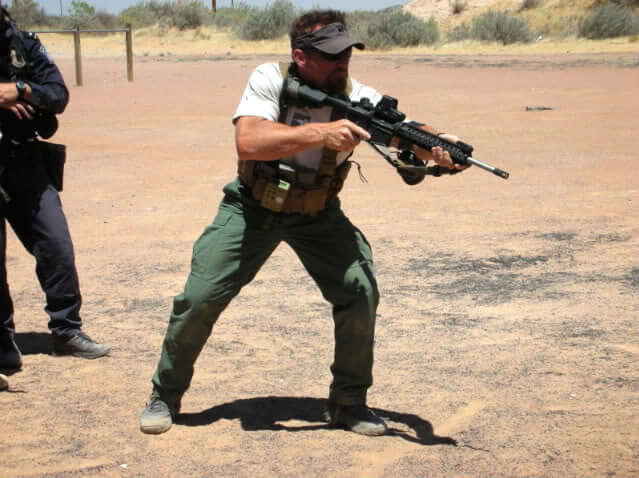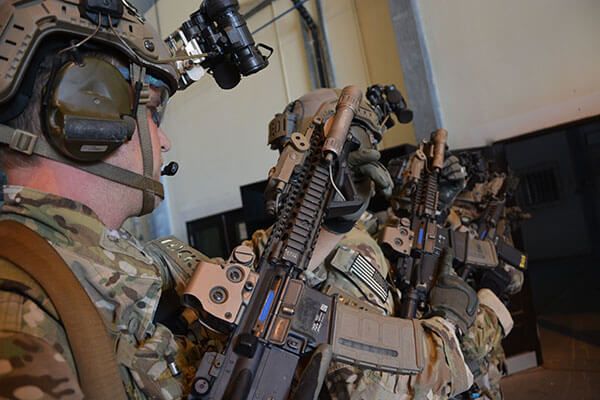To assume the low ready position, a shooter will hold a rifle in firing position but then simply drop the muzzle down slightly to allow clear observation over the top of the rifle, as illustrated in the image below.
The muzzle should be low enough to allow the shooter to clearly see the hands of potential targets, allowing for effective target discrimination. If necessary, to avoid pointing the weapon at fellow team members, a shooter can momentarily drop the muzzle lower.

Image: Pat McNamara employing the low-ready position (source: http://s557.photobucket.com/user/jaf0206/media/mac.jpg.htm)
To assume the high ready position, a shooter will raise the muzzle of the weapon up at approximately 45-degrees and tuck the stock of the weapon under the firing side arm, as illustrated in the image below.

Image: 7th Special Forces Group Soldiers employing the high-ready (image sourced from public domain | U.S. Army Photo by Staff SGT. Roman Madrid, 241st Mobile Public Affairs Detachment/Released)
The following is list of factual points and common arguments presented in favor of the low ready position. This is not intended as an all-inclusive list:
-
Holding the weapon in the low-ready does not obstruct observation. Raising the weapon into the high ready position blocks at least part of the shooter’s field of view on the firing side, especially when moving around corners in that direction. For example, holding the weapon high might prevent a shooter from seeing the hands of a subject crouched in the corner of a room, delaying effective target discrimination.
-
Because the stock remains locked in the shoulder, the shooter will be able to bring the sights on target much faster. It is more natural to acquire a target from low to high. In the high ready position, the shooter will have to bring the stock out from under the arm and re-establish the stock weld before firing, wasting valuable time. The shooter will also have to bring the weapon down on target from an angle since the weapon blocks the field of vision directly below the front sight.
-
If an enemy grabs the shooter’s weapon in the low ready, the shooter can still pull the trigger and fire rounds into the enemy’s abdomen, pelvic girdle or legs. If an enemy grabs a shooter’s weapon in the high ready, the weapon will fire harmlessly into the air.
-
Holding the weapon in the low ready is less fatiguing over time while holding the weapon high will tire the muscles and eventually reduce shooting accuracy.
-
The low ready reduces the chances of fatal fratricide. In contrast, bringing the weapon into action from the high ready in a downward motion makes it more likely that a shooter will accidentally shoot a teammate in the head.
-
If a shooter gets into the habit of holding the weapon at a very high angle (almost vertical) the shooter runs the risk of catching the muzzle on low-hanging branches, doorways, clotheslines and other obstacles. A weapon held at the low ready offers no such complications.
-
The low ready is a generally less intimidating posture and the shooter can more easily de-escalate a non-lethal confrontation by lowing the weapon just below the target.
The following is list of factual points and common arguments presented in favor of the high ready position. This is not intended as an all-inclusive list:
-
The most obvious reason to employ the high-ready is in situations where there is a potential threat located above the shooter, like stairwells, upper story windows and high walls. Oil rigs and ships also have numerous walkways and elevated platforms, which can make the high-ready useful for maritime operations to cover elevated threats. The high ready is also useful when moving through waist-deep water or thick, waist-high foliage.
-
The high ready provides a clear advantage for heavier weapons like the M249 SAW and M240B. Holding these weapons at the low ready is fatiguing unless the shooter lets the weapon hang from the sling. However, unlike the shorter carbine, it is rarely practical to let a heavy weapon hang from the sling pointing downwards, since it will smack against the shooter's legs during movement. Finally, the high ready position allows the weapon to naturally fall into position as the shooter drops to the prone while deploying the bipod. If held in the low ready, the shooter runs a greater risk of jamming the muzzle into the ground under high stress situations.
-
The high ready provides an advantage in physical contact or combat with an enemy because the shooter can strike down with the rifle at the enemy’s head.
Counter-Argument: The low ready is superior in a physical contact situation since the shooter can still fire into the enemy’s lower body. Furthermore, a downward strike with a rifle against a helmet or the top of the skull would prove only marginally effective and expose the shooter’s entire body and chest to enemy strikes.
-
The high-ready makes it less likely that a shooter will accidentally shoot another teammate.
Counter-Argument: A shooter employing the low-ready can just as easily drop the muzzle lower to avoid pointing the weapon at a teammate. However, the reduced observation associated with the high-ready makes it more likely that a shooter will accidentally drop the muzzle down and shoot a teammate in the head.
In conclusion, as with any hotly debated topic within the tactical community, there are no shortages of strong opinions regarding these two techniques. Sometimes those opinions are based on actual real world operator experience, other times they are based entirely on how someone else taught someone or something someone saw on YouTube.
As mentioned at the beginning of this article, the intent is not to advocate for one technique over the other, as they both have their place and purpose depending upon the circumstances. Rather, the intent is to omit opinions and simply provide a factual review of the considerations of each technique. Often, advocates of one technique may overlook or omit certain considerations in their arguments in favor of their preferred technique. What may work in one circumstance, or with an experienced operator or team, may not work in other circumstances or for less experienced personnel.
At the end of the day, it is ultimately up to the operator (or the unit) to select the most appropriate technique for the task based upon their level of experience and the circumstances in which they currently find themselves.


